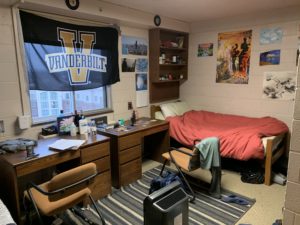Dean
For my paper, I am interested in comparing and contrasting the living environments of the Carmichael Towers suites with the group-living option at E. Bronson Ingram “EBI,” the newest dorm on campus. Towers was constructed in 1970, while EBI was completed almost fifty years later, in 2018. Apart from the obvious differences between the new versus old construction, there is significant variation in how the two dorms are arranged. For starters, the group-living option for EBI accommodates four people while the towers suites are home to six students. EBI suites are also comprised of four single rooms (where each student has his/her own room) whereas the towers suites offer a combination of two double rooms and two single rooms. In somewhat of a sadistic twist, too, one of the double rooms in towers is significantly larger and therefore more desirable than the other. Students are left to decide the pecking order for themselves, often surmising creative solutions to decide who gets first priority for the “big dub.”
Left is half of the small double; at right is half of the big double.


Despite the fact that EBI suites are home to (fewer – not “less”) less students, they are comparatively larger– in terms of space per person– than towers suites. Perhaps the most important per-person indicator is the fact that two less people are competing for the single bathroom in EBI than the one shower and toilet in Towers that are shared by six. The single bedrooms in EBI are also considerably larger than those in towers– and while they are smaller than both the small and large doubles in Towers, on a per-person basis each student has more individual space in EBI than in towers. The common room, in sheer terms, is also significantly larger than in Towers. Residents of EBI also have the benefit of more open study spaces while Towers residents are confined to a single room on the first floor.
However, while students in EBI have the benefit of more personal space and superior infrastructure, living in Towers offers some less-tangible benefits that are not possible in EBI. First and foremost, since the West Towers will be demolished in less than three months, residents have been given free range to paint and draw, at will, on the walls. As shown in the picture below, my suitemates and I have clearly taken advantage of the benefit. Of course, in the more posh EBI, this sort of behaviour would not be reprimanded with steep fines. Overall, many of my friends and I feel a sense of security living in Towers knowing that we won’t be liable for any damages that naturally occur over the course of a year. We have also appreciated and taken advantage of the immediate creative outlet that is offered by being able to draw and paint all over our walls. Without contest, the most impressive artistic spectacle in our suite is the waterfall and volcano landscape, which was made without the use of a single paintbrush, instead using tissues and napkins to blot the paint. [this paragraph is really interesting. One thing is clear, though. The only reason you’re getting to enjoy this kind of artistic freedom is because the towers are coming down! And it’s worth talking about why]

There is also a special feeling of being the last class to ever live in the Carmichael Towers. I can’t help but imagine the thousands of students that have lived here over the past 49 years, and the thousands of life-shaping events that have occurred within its cramped and drab concrete walls. At the end of its lifetime, Towers is a beckoning to earlier days at Vanderbilt and a useful baseline to consider the broader changes in the University that have paved the way for EBI: primarily an increase in overall funding, and a sharpened focus on creating learning communities in dorms.